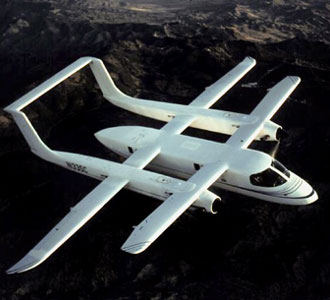Let's say that there is an aircraft with more than one main wing and each of these wings have elevators. Would it be necessary to have a horizontal stabilizer? The figure below shows an example of what I'm thinking.
1 Answer
Is horizontal stabilizer necessary for tandem wing aircraft? not if the main wings are capable of carrying out the functions of the tailplane.
The main reasons for horizontal stabilizer are twofold:
- To provide stability for the aircraft, as the wing alone configuration is unstable.
- To provide pitching moment as the long moment arm enables enough moment to be produced by small changes in the lift (via the elevators).
It provides other benefits too (like damping), but these are the main ones.
For aircraft having tandem wings (i.e. having two wings one behind the another), horizontal stabilizer may or may not be present depending on various factors.
- If the two wings are able to provide stability and provide pitch moment by differential control of the control surfaces (elevators) on them, the tandem wing has no horizontal stabilizer, like the Scaled Composites Proteus.
"Scaled Composites Proteus in flight 1". Licensed under Public Domain via Commons.
- In some cases, the above objectives may not be met with the wings alone and a horizontal tail may be required, like the Scaled Composites Advanced Technology Tactical Transport. Interestingly, the aircraft was flown in two configurations. The initial configuration had a cruciform tail.
Image Courtesy of Scaled Composites, LLC
According to DARPA report AD-A227- 498,
Analysis of the flight test results of the "Cruciform Tail" configuration disclosed a significant deficiency in the directional stability and engine-out minimum control speed of the airplane as well as some perceived loading difficulties due to low clearance of the aft cargo door.
As a result, the configuration was changed into a twin boom 'bronco' tail and flown.
Image Courtesy of Scaled Composites, LLC
There are some advantages with the tandem wing configuration, like:
- For same weight, the tandem wings are more compact (i.e. have less wingspan) as both the wings produce lift (This was one of the reasons given by Burt Rutan). They have less frontal area and less parasite drag.
- In case of tandem wings, both the wings produce lift, on either side of the center of gravity and produce moments about the c.g. in opposite directions. So, for stability, the c.g. is shifted forwards (for e.g. by having the power-plant forward). As the Angle of attack (aoa) increases, the lift force shift towards the rear and as the center of pressure shifts to the rear of c.g., the tail has to produce higher downward force to produce the required counteracting moment. As higher aoa is used mostly in landings, where more lift is required at lower speeds, this is not ideal. However, in case of tandem wings, at higher aoa, lift force of both the wings move to the rear, resulting in the rear wing having longer moment arm, and by extension, larger moment. So to compensate, the lift produced by the front wing has to be larger, which produces more lift, not less. For this reason, the front wing is set at a higher incidence (so as to produce higher lift) compared to the rear one.
Source: nurflugel.com
- In general, the c.g. of a tandem wing aircraft is towards the main forward wing with the rear wing at a smaller incidence compared to the forward one. This means that the forward wing will have higher wing loading and stall first. However, as the rear wing is still producing lift, the nose drops and the front wing starts to produce lift again, giving the pilot some time to react and control the aircraft, unlike the conventional configuration.
As the wingspan is less, the induced drag is more though.






not includethe main wings. $\endgroup$each of these wings have elevators, then in the examples you give, none of them has elevators on the wings (which btw, cannot work, the elevators must have a long lever to the CoG). They also have horizontal stabilisers. Is your question simply what are the small additional wings at the front? If so, you are asking about canards. $\endgroup$